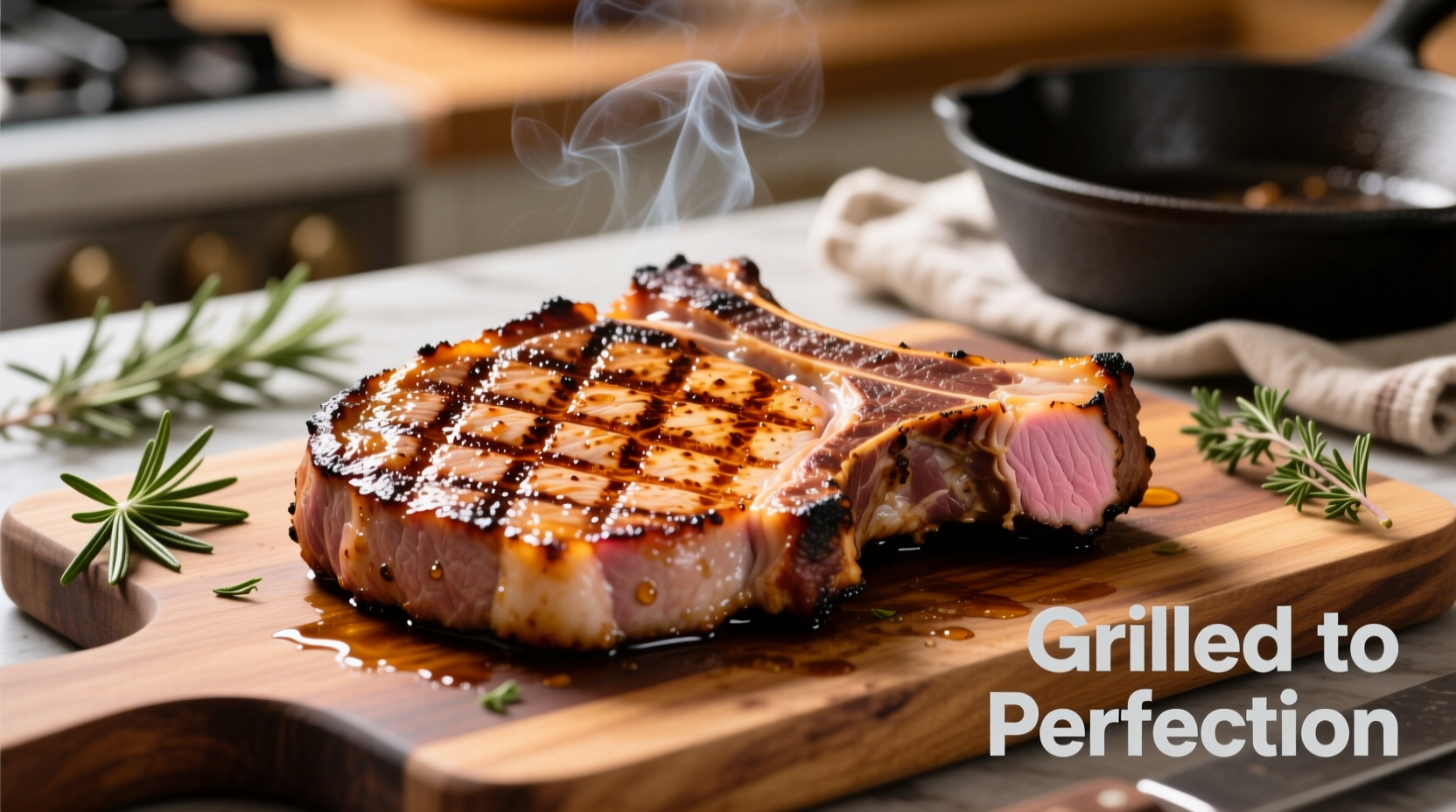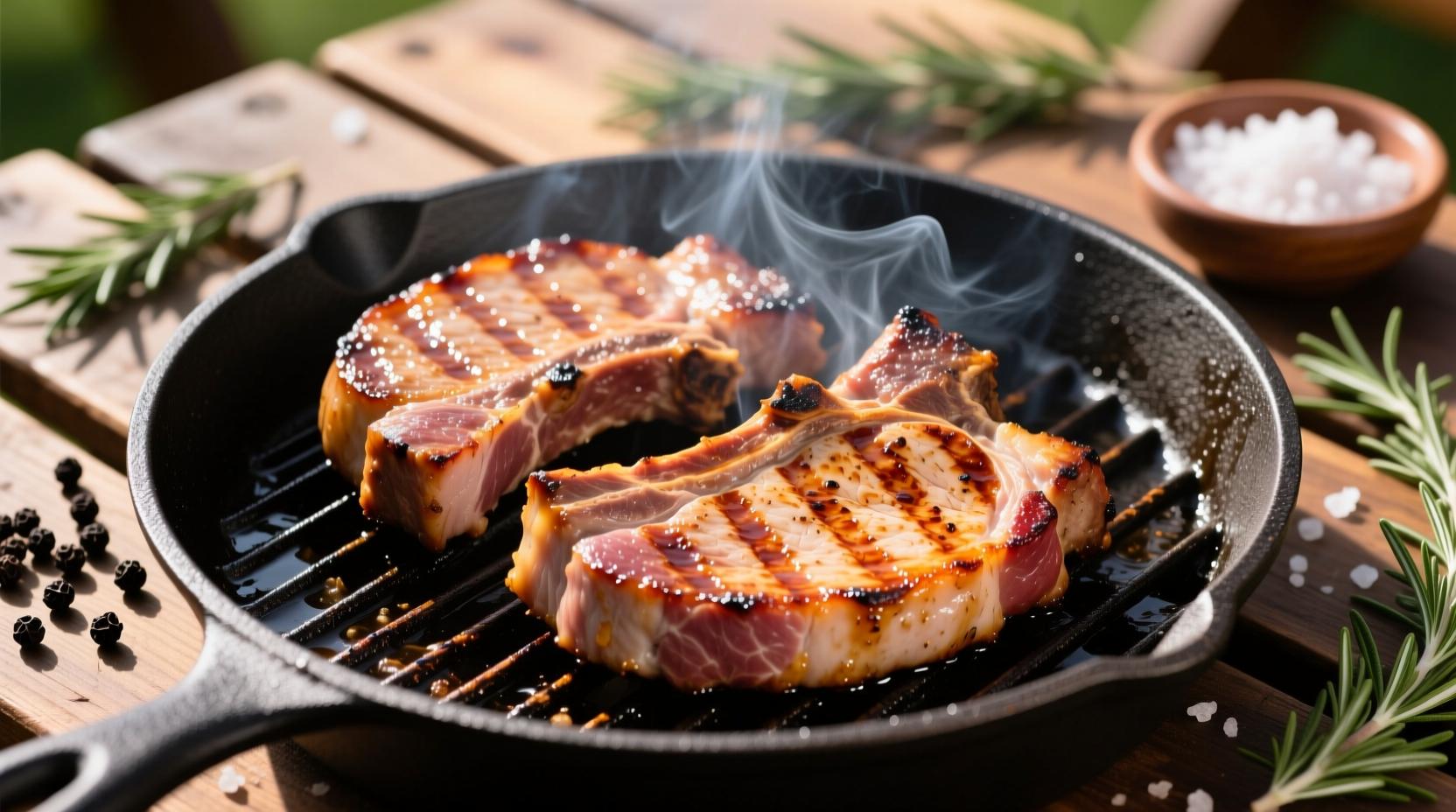Grilling pork chops transforms this humble cut into a restaurant-quality meal with minimal effort. Forget dry, overcooked results—this guide delivers consistently juicy, flavorful pork chops with professional techniques you can master in under 30 minutes. Whether you're using gas or charcoal, thick or thin cuts, these evidence-based methods solve the most common grilling challenges home cooks face.
Selecting the Perfect Pork Chops for Grilling
Not all pork chops are created equal for grilling. Bone-in rib or loin chops between 1 and 1.5 inches thick provide the ideal balance of meat-to-bone ratio and cooking time. The bone acts as a natural heat conductor while protecting the meat from drying out. Look for chops with even pink coloration and fine marbling—avoid any with excessive liquid in the packaging, which indicates poor handling.
According to the USDA Food Safety and Inspection Service, properly handled fresh pork should maintain temperatures below 40°F until preparation. This temperature control prevents bacterial growth that could compromise both safety and texture.
| Chop Type | Best For Grilling? | Recommended Thickness | Cooking Time |
|---|---|---|---|
| Bone-in Rib Chop | Excellent | 1-1.5 inches | 18-22 minutes |
| Boneless Loin Chop | Good | 1 inch | 14-18 minutes |
| Center Cut Chop | Fair | 3/4 inch | 10-14 minutes |
| Butterfly Chop | Poor | N/A | Not recommended |
Essential Preparation Techniques
Proper preparation separates good grilled pork from exceptional results. Remove chops from refrigeration 45-60 minutes before grilling to bring them to room temperature—this ensures even cooking throughout. Never skip this step, as cold meat placed directly on hot grills creates significant temperature gradients that lead to overcooked exteriors and undercooked centers.
For maximum flavor and moisture retention, consider a simple brine: dissolve 1/4 cup kosher salt and 2 tablespoons sugar in 4 cups of cold water. Submerge chops for 30-60 minutes, then pat thoroughly dry. This process enhances moisture retention by up to 25% according to research published by the USDA National Institute of Food and Agriculture.

Mastering Grill Setup and Temperature Control
Successful grilling requires proper temperature management. For gas grills, preheat on high for 10-15 minutes with the lid closed, then create two zones: one at 400-450°F for searing and another at 300-350°F for finishing. Charcoal users should arrange coals on one side for direct heat and leave the other side empty for indirect cooking.
Clean your grates thoroughly with a brass brush, then oil them using tongs and a folded paper towel dipped in high-smoke point oil. This prevents sticking without adding excess oil that could cause dangerous flare-ups. The ideal surface temperature for searing pork chops is 400-450°F—use an infrared thermometer to verify before placing meat on the grill.
Step-by-Step Grilling Process
Follow this precise sequence for perfect results every time:
- Season chops generously with salt, pepper, and optional spices 15 minutes before grilling
- Place chops on the hottest part of the grill at a 45° angle to create attractive sear marks
- Cook undisturbed for 4-6 minutes until they release naturally from the grates
- Rotate 90° for crosshatch marks and cook another 2 minutes
- Flip and repeat on the other side
- Move to indirect heat when internal temperature reaches 125°F
- Continue cooking until reaching 145°F internally
- Remove and rest for 5 minutes before serving
Use an instant-read thermometer inserted horizontally into the thickest part of the chop—not touching the bone—to check doneness. The USDA updated its pork cooking guidelines in 2011, lowering the recommended safe internal temperature from 160°F to 145°F with a 3-minute rest period. This change, verified by the Centers for Disease Control and Prevention, maintains food safety while preventing overcooking.
Resting and Serving for Maximum Juiciness
The resting period is non-negotiable for juicy results. During the 5-minute rest, residual heat continues cooking the meat while proteins relax, redistributing juices throughout the chop. Cutting too soon releases these precious juices onto your cutting board rather than staying in the meat.
For enhanced flavor, place a pat of compound butter on each chop during the resting period. As it melts, it creates a luxurious sauce that complements the natural pork flavors. Serve with grilled vegetables or a simple starch to complete the meal.
Troubleshooting Common Grilling Problems
Problem: Flare-ups causing burnt exteriors
Solution: Move chops to indirect heat zone immediately. Trim excess fat before grilling to prevent future flare-ups.
Problem: Uneven cooking with raw centers
Solution: Always bring chops to room temperature first and use two-zone grilling method to finish cooking without burning.
Problem: Dry, tough texture
Solution: Overcooking is the primary culprit. Use a thermometer and remove chops at 140°F—they'll reach 145°F during resting.
Flavor Variations to Try
Once you've mastered the basic technique, experiment with these professional variations:
- Applewood Smoked: Add applewood chips to your charcoal or smoker box for subtle fruitwood notes
- Garlic-Herb: Create a paste with minced garlic, fresh rosemary, thyme, and olive oil
- Spicy Maple: Brush with a mixture of pure maple syrup and cayenne during the last 2 minutes
- Mustard Crusted: Coat with Dijon mustard and press fresh breadcrumbs onto the surface before grilling
Remember that sugar-based marinades and glazes can cause rapid charring. Apply these during the last 5 minutes of cooking to prevent burning while still achieving delicious caramelization.
When Grilling Isn't the Best Option
While grilling produces excellent results in warm weather, consider these limitations:
- Rainy or extremely cold weather makes temperature control difficult
- Thin chops (under 3/4 inch) cook too quickly and easily overcook
- Indoor grilling with small electric units lacks the radiant heat of outdoor grills
- Apartment dwellers without outdoor space may need alternative methods
In these situations, consider pan-searing followed by oven finishing—a technique that mimics grill results indoors. The key principle remains consistent: high initial heat for searing followed by gentler cooking to reach proper internal temperature.
Frequently Asked Questions
How long should I grill 1-inch thick pork chops?
Grill 1-inch thick pork chops for 4-6 minutes per side over direct heat at 400-450°F, then move to indirect heat until reaching 145°F internal temperature. Total cooking time typically ranges from 14-18 minutes depending on grill temperature and meat thickness.
Should I marinate pork chops before grilling?
Marinating isn't necessary but can enhance flavor. A simple salt brine (1/4 cup salt dissolved in 4 cups water) for 30-60 minutes improves moisture retention significantly. For acidic marinades containing citrus or vinegar, limit time to 2 hours maximum to prevent texture deterioration.
Why are my grilled pork chops dry?
Dry pork chops typically result from overcooking. Use an instant-read thermometer and remove chops at 140°F—they'll reach the safe 145°F during the 5-minute rest period. Skipping the rest period also causes juices to escape when cutting.
Can I grill frozen pork chops?
Never grill frozen pork chops directly. The exterior will burn before the interior reaches a safe temperature. Always thaw pork chops completely in the refrigerator before grilling for even cooking and food safety.
What's the best wood for smoking pork chops?
Mild fruitwoods like apple, cherry, or pecan complement pork without overwhelming its delicate flavor. Avoid strong woods like hickory or mesquite for thin cuts like chops, as they can create bitter, overpowering smoke.











 浙公网安备
33010002000092号
浙公网安备
33010002000092号 浙B2-20120091-4
浙B2-20120091-4